Delosperma zoutpansbergense
Delosperma zoutpansbergense L.Bolus
Family: Aizoaceae
Common names: Soutpansberg delosperma (Eng.), Soutpansberg-vygie (Afr.)
Introduction
Delosperma zoutpansbergense is only known from south-facing upper cliffs along the upper Soutpansberg near Louis Trichard (Machadu) in Limpopo Province. A fast grower, it has soft flaccid growth, from a more compact central part, becoming sprawling. The leaves are linear lanceolate, sightly grooved at the top and keeled at the base and the surface is covered in shiny papillae. Attractive dark purplish-pink flowers appear in spring and summer. It is a cliff-squatter and can be used as a pot plant or hanging basket.

Fig. 1. Delosperma zoutpansbergense in flower in habitat on a cliff face at Hanglip, Soutpansberg, Limpopo Province sharing its habitat with Coleus mutabilis. The plant grows on a sheer south facing rock face.
Description
Description
Delosperma zoutpansbergense is a soft, fragile, sprawling succulent perennial, forming small to larger mats about 100 mm high and up to about 300 mm in diameter and often becoming drooping on narrow cliff ledges. The roots are fibrous. The flowering branches die back to a central base during winter. The stems are flaccid, sometimes brownish green, and covered in shiny papillae; the nodes 20–40(–45) mm apart. The leaves spreading ascending (curving upwards), subterete, linear and 10–50 × 2–4 mm. The surface is covered with distinct papillae, the upper surface (adaxial surface) channelled and the leaf tip acute. The young basal leaves are ovate-lanceolate. The flowers are solitary, 27–30 mm in diameter, the pedicels up to 15 mm long. They close during the night and open during the day. The petals are linear-lanceolate, 10–13 × 0.75–1.25 mm, pink. The filamentous staminodes (inner portion of flower) pink with pale tips . Capsule and seed not seen. Flowering is mainly in spring and summer.
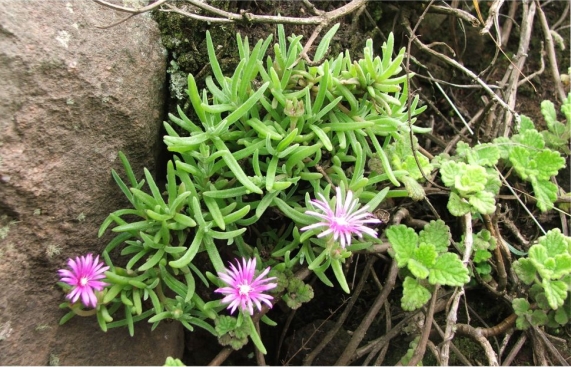
Fig. 2. Delosperma zoutpansbergense in flower in its habitat, growing on sheer, south-facing rock faces on the cliffs at Hanglip, Soutpansberg (Limpopo Province), sharing its habitat with Coleus mutabilis. Dec 2005.
Conservation Status
Status
Plants are only known from the upper reaches of the Soutpansberg. They are well protected by the sheer cliffs and, therefore, are not threatened. Consequently it was has a status of Least Concern (LC) on SANBI’s Red List of South African Plants.
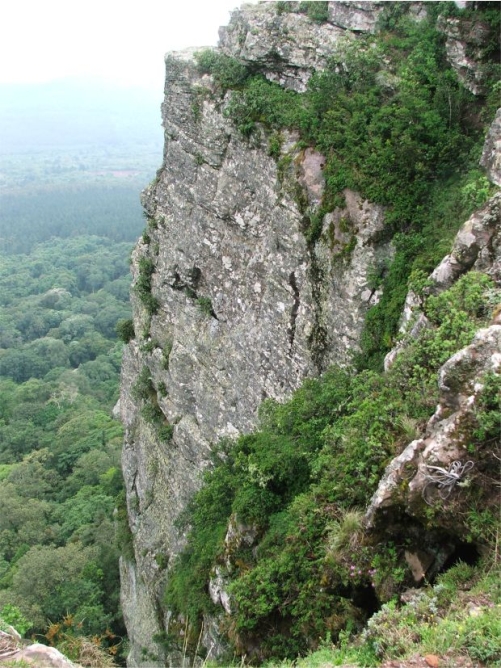
Fig. 3. Hanglip, Soutpansberg, Limpopo Province, habitat of Delosperma zoutpansbergense, the plants grow on a moist, south-facing cliff with ferns and liverwort. Note the Afromontane forest below.
Distribution and habitat
Distribution description
Delosperma zoutpansbergense is only known from the upper, sheltered, south-facing cliffs of the Soutpansberg, Limpopo Province. They grow just above the Afromontane forest zone. Plants are rooted in crevices and on ledges. Temperatures are moderate, the average daily maximum about 25°C and average daily minimum for the region 10°C. Winters are cool but frost is absent or light. Rainfall occurs mainly in summer, 1250–1500 mm per annum and with frequent fog. Plants grow at an altitude of about 1500–1730 m. The associated vegetation consists of a mosaic of Soutpansberg Summit Sourveld and the Northern Misbelt Forest (Mucina et al. 2006). The habitat during summer remains moist due to the high rainfall and frequent fog. Associated plants on the cliff face include various lichens, mosses and species of lithophytic (rock dwelling) ferns. It also shares its habit with the following succulents and semi-succulent plants: Aeollanthus buchnerianus, Aloe arborescens, Crassula swaziensis, Kalanchoe crundallii, Pelargonium graveolens, Plectranthus mutabilis and Thorncroftia succulenta. The geology consist of hard Protozoic quartzitic sandstone (Soutpansberg Group, Wyllies Poort Formation) (Barker et al.2006).

Fig. 4. Two Delosperma zoutpansbergense plants growing close to a boulder, Hanglip, Soutpansberg, Limpopo Province, December 2005.
Derivation of name and historical aspects
History
Delosperma zoutpansbergense was first collected by the botanist Albert Mogg (1886-1980) a South African Botanist and Curator of the Moss Herbarium in Gauteng (Gunn & Codd 1981). Louisa Bolus of the Bolus Herbarium named the plant in 1959 in the Journal of South African Botany, after the Soutpansberg where Albert found it, Zoutpansberg is the original spelling. Cuttings were sent to Kirstenbosch in 1959 where plants were grown (NBG 2/59). The author investigated and collected plants again, as part of his studies on succulents confined to cliff faces, at Hanglip, Soutpansberg on 6 December 2005 (NBG 454/06), where he found the plant in full flower.
Delosperma zoutpansbergense belongs to a soft and flaccid-stemmed group from the summer rainfall grassland regions. Although perennial they have a limited life span of 3-5 years and new populations are established from seed. The other closely related species include D. zeederbergii (endemic to the upper reaches of the Spekboomrivier in Mpumalanga) and D. waterbergensis (endemic to the Waterberg in Limpopo), all obligatory cliff dwellers, found on cooler south facing aspects, summer growers, growing on mineral poor quarzitic sandstone soil.

Fig. 5. Delosperma zoutpansbergense plants growing at Hanglip, Soutpansberg, Limpopo Province. The plant shares its cliff habitat with several other plants including lithophitic orchids, Elaphoglossum, mosses, ferns and lichens. The habitat is subject to regular fog and remains moist throughout the summer.
Ecology
Ecology
The plants grow firmly rooted in crevices and on ledges, in a habitat with shallow and limited soil, and without competition from aggressively growing large grasses, perennials and shrubs. The succulent leaves enable the plant to withstand periods of drought. The large pointed papillae that are densely packed on leaves and stems, both store moisture and assist with trapping dew and fog. Fog regularly occurs on the upper part of the Soutpansberg during summer, providing additional moisture. The plant is a rapid grower from a central rootstock, the rapidly growing flowering branches die back during the dry winter months, but the central portion remains intact, sprouting again in spring. The younger juvenile leaves are shorter, ovate lanceolate and often becoming purplish. The betanin pigment helps with a slow down on photosynthesis during the dry period.
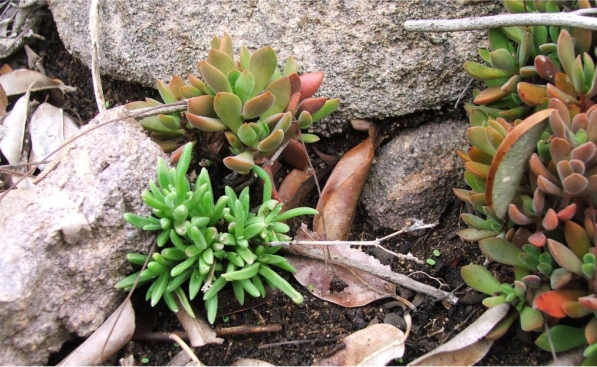
Fig. 6. A Delosperma zoutpansbergense plant growing among Crassula swaziensis. The plant is still in its juvenile compact phase. Note the remains of previous seasons flowers and fruits.
The plants are floriferous, flowering in profusion and are pollinated by bees and other small insects. The seed is retained in the hygrochastical capsules. It is only released during rain periods when the expanding keels of the capsule force open the cell lids and the seeds are splashed out from the capsule by the falling raindrops and dispersed. Delosperma fruiting capsules do not have covering membranes as found in many other mesembs (hence the genus name delos meaning ‘naked’, and sperma meaning ‘seed’. However upon drying, the cell lids are closed again contracting the keels and conserving the seed until the next rain shower.
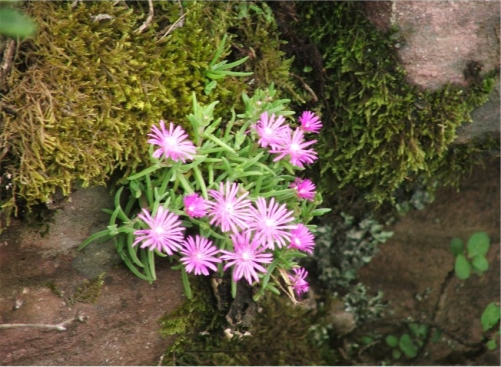
Fig. 7. Delosperma zoutpansbergense drooping from a cliff at Hanglip, Soutpansberg, growing with a species of moss, a good indicator of the high rainfall and regular fog.
Uses
Use
Delosperma zoutpansbergense can be grown as a succulent ornamental. It is easily grown, even outside of its habitat.
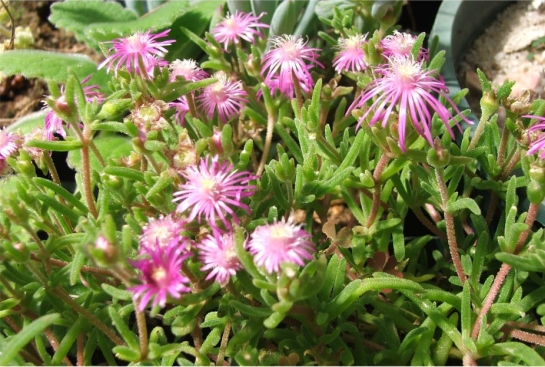
Fig. 8. Delosperma zoutpansbergense in cultivation at Kirstenbosch National Botanical Garden.
Growing Delosperma zoutpansbergense
Grow
Although Delosperma zoutpansbergense is easily grown and is a succulent plant, it needs regular watering during the summer months, at least 3 times a week. Plants are best grown in a container and placed on a south-facing aspect, and are tolerant of dappled shade. They are adapted to grow on mineral-poor, quarzitic sandstone soil and thus need a well-drained (sandy) soil. The plants react well to an organic fertiliser, and to compost and are best suited for cool grassland gardens. Due to its specialized cliff habitat that it shares with limited species, it cannot compete with more aggressive growing plants, therefore, make sure that it is not overgrown by more aggressive neighbours (Van Jaarsveld 2010). They are rapid growing and should flower during the first season. At Babylonstoren Farm plants are grown in ceramic containers in shady conditions.
Propagate from stem cuttings 7-12 cm length in summer or autumn, remove the lower leaves and plant the stems to a depth of about 1-4 cm in a sandy mixture. Keep moist until well rooted.
Plants grow well in a general succulent mixture, such as 2 parts sand, 1 part garden loam and 1 part well broken down compost. It is adaptable to other soils but good drainage is essential and regular moisture during the summer months.
References
- Barker, O.B. et al. 2006. The Soutpansberg and Waterberg groups and the Blouberg Formation In: M.R. Johnson et al. (eds.), The geology of South Africa. Geological Society of South Africa. Johannesburg/Council for Geoscience, Pretoria, 301-318.
- Bolus, L. 1959. Notes on Mesembryanthemum and allied Genera. Journal of South African Botany 25: 371-374
- Bolus, L. 1963. Notes on Mesembryanthemum and allied Genera. Journal of South African Botany 29: 45-49..
- Burgoyne, P.M. 2006. Delosperma zoutpansbergense L.Bolus. National Assessment: Red List of South African Plants version 2020.1. http://redlist.sanbi.org/species.php?species=137-184. Accessed on 2023/03/07
- Gunn, M. & Codd, L.E. 1980. Botanical exploration of southern Africa. Balkema, Cape town.
- Hartmann, H.E.K. 1991. Mesembryanthema. Systematics, biology and evolution of some South African taxa. Contributions from the Bolus Herbarium. No. 13: 75–157.
- Hartmann, H.E.K. 2001. Aizoaceae A–E. In Eggli, U. & Hartmann, H.E.K. (eds.), Handbook of succulent plants. Springer. Heidelberg, New York, etc.
- Lavis, M. 1969. Notes on the genus Delosperma (Mesembrieae). Journal of South African Botany 35: 145–147.
- Mucina, L. & Rutherford, M.C. (eds) 2006. The vegetation of South Africa, Lesotho and Swaziland. Strelitzia 19. South African National Biodiversity Institute, Pretoria.
- Van Jaarsveld, E.J. 2010. Waterwise gardening in South Africa and Namibia. Struik, Cape Town.
Credits
Ernst van Jaarsveld
Kirstenbosch National Botanical Garden (Retired 2015)
Babylonstoren Farm
Extraordinary senior lecturer and researcher,
Department of Biodiversity and Conservation, University of the Western Cape
March 2023
Acknowledgements: the author thanks Freddie van Wyk and uPakhamani Xaba for their help in the field, and also his wife Erma and Henk van Jaarsveld for assistance in the field.
Plant Attributes:
Plant Type: Shrub, Succulent
SA Distribution: Limpopo
Soil type: Sandy
Flowering season: Spring, Early Summer, Late Summer
PH: Acid
Flower colour: Pink
Aspect: Full Sun, Morning Sun (Semi Shade), Afternoon Sun (Semi Shade)
Gardening skill: Easy
Special Features:
Horticultural zones







Rate this article
Article well written and informative
Rate this plant
Is this an interesting plant?
Login to add your Comment
Back to topNot registered yet? Click here to register.